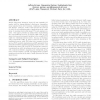Free Online Productivity Tools
i2Speak
i2Symbol
i2OCR
iTex2Img
iWeb2Print
iWeb2Shot
i2Type
iPdf2Split
iPdf2Merge
i2Bopomofo
i2Arabic
i2Style
i2Image
i2PDF
iLatex2Rtf
Sci2ools
110
Voted
CCR
2011
2011
HTTP in the home: it is not just about PCs
HTTP (Hypertext Transport Protocol) was originally primarily used for human-initiated client-server communications launched from web browsers, traditional computers and laptops. However, today it has become the protocol of choice for a bewildering range of applications from a wide array of emerging devices like smart TVs and gaming consoles. This paper presents an initial study characterizing the non-traditional sources of HTTP traffic such as consumer devices and automated updates in the overall HTTP traffic for residential Internet users. Among our findings, 13% of all HTTP traffic in terms of bytes is due to nontraditional sources, with 5% being from consumer devices such as WiFi enabled smartphones and 8% generated from automated software updates and background processes. Our findings show that 11% of all HTTP requests are caused by communications with advertising servers from as many as 190 countries worldwide, suggesting the widespread prevalence of such activities. Overall, o...
| Added | 13 May 2011 |
| Updated | 13 May 2011 |
| Type | Journal |
| Year | 2011 |
| Where | CCR |
| Authors | Jeffrey Erman, Alexandre Gerber, Subhabrata Sen |
Comments (0)

